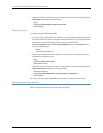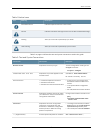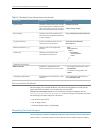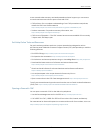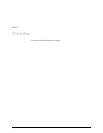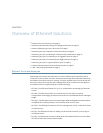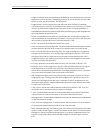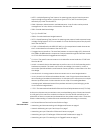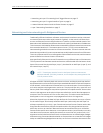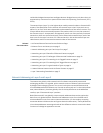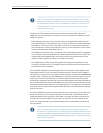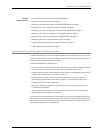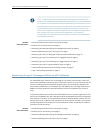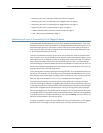
•
bridge—A network component defined by theIEEE thatforwards framesfrom one LAN
segment or VLAN to another. The bridging function can be contained in a router, LAN
switch, or other specialized device. See also switch.
•
bridge domain—A set of logical ports that share the same flooding or broadcast
characteristics.Asin avirtual LAN,a bridgedomain spansone ormoreports ofmultiple
devices. By default, each bridge domain maintains its own forwarding database of
MACaddresseslearned frompackets receivedonports belonging tothatbridgedomain.
See alsobroadcast domain and VLAN.
•
B-TAG—A field defined in the IEEE 802.1ah provider MAC encapsulation header that
carries the backbone VLAN identifier information. The format of the B-TAG field is the
same as that of the IEEE 802.1ad S-TAG field. See also S-TAG.
•
B-VID—The specific VLAN identifier carried in a B-TAG.
•
CFM—Connectivity-fault management. Thepartof EthernetOAMthatmonitorsevents
at levels above the physical level, as does LFM. See also OAM, LFM, and ETH-DM.
•
CIST—Common and Internal Spanning Tree. The single spanning tree calculated by
the spanning tree protocol (STP) and the rapid spanning tree protocol (RSTP) and
the logical continuation of that connectivity through multiple spanning tree (MST)
bridges and regions, calculated to ensure that all LANs in the bridged LAN are simply
and fully connected. See also MSTI.
•
ETH-DM—Ethernet Frame Delay Measurements. See also OAM, CFM, and Y.1731.
•
Ethernet—A term loosely applied to a family of LAN standards based on the original
proprietary Ethernet from DEC, Intel, and Xerox (DIX Ethernet), and the open
specifications developed by the IEEE 802.3 committee (IEEE 802.3 LANs). In practice,
few LANs comply completely with DIX Ethernet or IEEE 802.3.
•
IRB—Integrated bridging and routing. IRB provides simultaneous support for Layer 2
bridging and Layer 3 routing within the same bridge domain. Packets arriving on an
interface of the bridge domain are Layer 2 switched or Layer 3 routed based on the
destination MAC address. Packets addressed to the router's MAC address are routed
to other Layer 3 interfaces.
•
I-SID—The 24–bit service instance identifier field carried inside an I-TAG. The I-SID
defines the service instance to which the frame is mapped.
•
I-TAG—A field defined in the IEEE 802.1ah provider MAC encapsulation header that
carries the service instance information (I-SID) associated with the frame.
•
learning domain—A MACaddressdatabase where theMACaddressesareadded based
on the normalized VLAN tags.
•
LFM—Link fault management. A method used to detect problems on links and spans
on an Ethernet network defined in IEEE 802.3ah. See also OAM.
•
MSTI—Multiple Spanning Tree Instance. One of a number of spanning trees calculated
by MSTP within an MST region. The MSTI provides a simple and fully connected active
topology for frames classified as belonging to a VLAN that is mapped to the MSTI by
the MST configuration table used by the MST bridges of that MST region. See also
CIST.
Copyright © 2010, Juniper Networks, Inc.4
Junos 10.4 MX Series Ethernet Services Routers Solutions Guide



